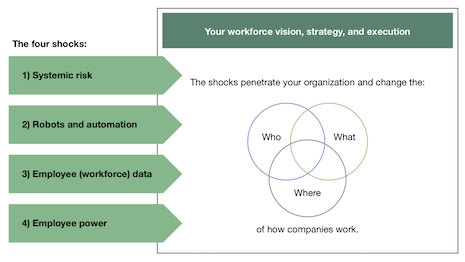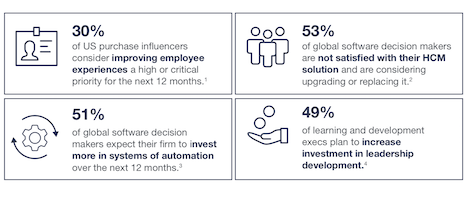
Four shocks assault current workforce strategy from the outside, according to Forrester. Image courtesy of Forrester
By Dianna Dilworth
The workplace will not go back to what it once was and CEOs will have to transform their approach to running businesses with the impact of the COVID-19 fallout.
Many of these workplace transformations were actually inevitable and only accelerated by the pandemic, according to Forrester’s Research's latest report, “The CEO’s Guide to the Future: Key Takeaways.”
“The current pandemic is an acute symptom of a larger set of factors that were already poised to alter the way your workforce does its job,” said James L. McQuivey, vice president and principal analyst at Forrester, in the report.
“Tools like employee experience and human capital management are ready to help," he said. "Most executives intended to focus on these things anyway. A new urgency will now propel their investment.”
Cambridge, MA-based Forrester is one of the leading digital and marketing-oriented market researchers.
 James L. McQuivey is vice president and principal analyst at Forrester Research, and author of the report. Image credit: Forrester
James L. McQuivey is vice president and principal analyst at Forrester Research, and author of the report. Image credit: Forrester
Four shocks to the system
The COVID-19 pandemic has become a systemic risk that companies across the globe have had to adapt to, from creating work-from-home programs to managing supply chain challenges and going more digital.
Many of the new changes that are happening now were already beginning to take place even before the world got sick and shut down.
Digital automation has been quietly building in the background and this will continue into the next decade. In fact, automation of some sort will transform 80 percent of jobs by 2030, according to the report.
“Many of the tasks your workforce does today can be done better and, in some cases, more cheaply, by robots, artificial intelligence (AI), and other automation technologies,” the report said. “But we are only a few steps down the path to understanding what this means for your industry, your company and your job.”
One thing CEOs should be aware of is the massive amounts of employee data that is growing and for which they will be responsible.
Interestingly, 90 percent of employees said they are willing to let employers use data about them if they benefit from that usage in some way.
“Your systems for managing people operations and strategies — i.e., human capital management (HCM) technology — collect more data about your current and potential workforce than you know what to do with,” the report read.
“The potential for misuse of workforce data is at an all-time high and climbing. The newly urgent need to track the whereabouts and well-being of your workforce — including the expanding base of non-employee contributors whose data will create further complexity — means this tsunami won’t crest soon.”
Additionally, employees will become empowered in new ways, similar to how customers were empowered in the past.
“Just as the age of the customer empowered consumers, today’s personal technology empowers your employees to surveil the corporate world for companies that share their personal values,” the report said. “How did this company treat employees during the pandemic? Does the CEO donate to causes I don’t approve of?
"That surveillance upends the power to control the narrative in the way that HR and PR once could.”
 Executives want to improve their future-of-work tool capabilities. Image courtesy of Forrester
Executives want to improve their future-of-work tool capabilities. Image courtesy of Forrester
Way forward
As CEOs look to navigate the new world order, companies should place an emphasis on the employee experience (EX) to build empathy and deepen engagement with their staff.
While this has been traditionally a low priority investment in the coming year, the pandemic is beginning to change this. Companies are using employee engagement pulse surveys as one part of an employee listening strategy to learn more about team members' sentiments, workload and wellness.
As companies go more digital, Forrester recommends that companies use the robotics quotient (RQ) metric to guide their approach to automation. This RQ metric looks at how the people and teams adapt to automation and AI technologies and how they are willing to use them.
"The reason automation deployments fail isn’t generally because companies have chosen the wrong technology or vendor," the report said. "It’s because their employees and organization can’t effectively integrate the technology into business processes."
Even as digital gains ground, human-centric leadership should be central to leading organizations.
During the beginning of the pandemic, only 48 percent of U.S. workers felt confident that their chief executive could manage a crisis.
"The pace of change was rising even before the arrival of COVID-19, but the pandemic made it clear that workers want leaders capable of providing human-centered solutions," Forrester's report said.
"Leaders at all levels of the organization, including line managers, need to work from a common set of values that support high performance. Now is the time to double-down on leadership investments to optimize EX."
 Four shocks assault current workforce strategy from the outside, according to Forrester. Image courtesy of Forrester
Four shocks assault current workforce strategy from the outside, according to Forrester. Image courtesy of Forrester
 James L. McQuivey is vice president and principal analyst at Forrester Research, and author of the report. Image credit: Forrester
James L. McQuivey is vice president and principal analyst at Forrester Research, and author of the report. Image credit: Forrester Executives want to improve their future-of-work tool capabilities. Image courtesy of Forrester
Executives want to improve their future-of-work tool capabilities. Image courtesy of Forrester